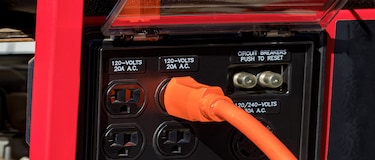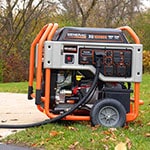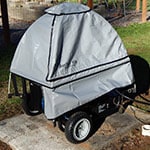
Generator Quick Start Guide
How to Start a Generator
When a storm strikes and your power is knocked out, you want to get your portable generator up and running-fast.
You may have bought your generator a few years ago and don't remember how it starts. But when a blackout takes down the neighborhood, you just want your power back as soon as possible.
Save these instructions as a reference guide so you know how to turn on your generator when you need it most.
Preparation
1. Consult your owner's manual 
2. Check for damage or gas leak
If your building was struck by a storm, it's a good idea to check for damage. Most importantly, you don't want to use a gasoline-fueled generator if you have experienced a natural gas leak.
3. Move your generator outside, away from the house
We can't stress this point enough: run your generator outside, at least 15 feet from your house. NEVER operate a generator inside of your home, garage, or shed. If you use a generator inside your garage you could be killed by carbon monoxide poisoning within minutes. 
4. Don't operate your generator (unprotected) in a storm Heavy rain can cause electrical shock and damage to the engine. But if you need to run a generator while it's raining, you can buy a generator tent to help protect your product from the elements.
5. Check fuel levels for oil and gas
You use gas to fuel a portable generator. Always make sure you fill up your generator with FRESH gasoline. Ethanol in the gas will absorb water over time. Stale gasoline not only makes it harder or impossible to start, but can damage the engine. Also, check the oil level of your generator to make sure the engine gets proper lubrication. Fill the oil up to the line specified on the generator.
6. Remove any cords plugged into the generator
Before starting the generator, disconnect all cords. You should start your generator before connecting it to your home. You don't want any load attached during the startup.
Next: Turning On Your Generator
1. Turn fuel valve on
2. Turn choke on
Move the choke rod from right to left. This makes it easier for the engine to start running.
3. Turn ignition (or engine switch) on
Many generators require you to flip the switch to turn the engine on. This is essentially an engine switch that will flip on before you pull the recoil cord.
4. Pull recoil cord
When you pull the recoil cord, you are actually starting the engine. Pull the recoil cord until you feel a bit of resistance and then let it go back. If the engine doesn't start, try pulling the cord again.
5. After the engine starts, move engine choke to "run"
When the engine has been running for a few moments, you can move the choke back to the "run" position.
Connecting Your Generator to Your Home
Let the generator run a few minutes before plugging in any cords. Also, make sure you have turned your circuit breakers on. After it has run for 3-5 minutes, you can begin connecting it to the house. There are a few ways to restore your power:
1. Extension cords
If you are powering something like Christmas lights or a lamp, a light-duty, 16-gauge extension cord will do just fine. But these light duty cords are a fire hazard for most appliances you would plug into a generator.
For most items you will want at least a heavy-duty, 12-gauge extension cord, or an extra heavy-duty 10-gauge extension cord. For example, a 10-gauge extension cord would be ideal for your refrigerator.
Another option is a simple convenience cord, which allows you to plug in multiple items at once. Instead of plugging in individual appliances to the generator, you plug in this cord, extend it out to wherever most of your appliances reside, and plug in multiple appliances from there.
3. Through-the-wall kit
With a through-the-wall kit for your portable generator, you can power your indoor appliances without having to run cords outside.
Simply drill through the wall to connect an indoor power panel with an outdoor power inlet box. Then, connect your generator to the outdoor power inlet box with a power cord. Finally, you can plug your indoor appliances into the indoor power panel, and the generator will power them.
4. Power Cord & Transfer Switch
Finally, you can use a manual transfer switch with a generator power cord.
Instead of powering individual appliances using extension cords, a transfer switch allows you to power critical loads in your home's circuit panel.
As a result, this means you can run household hard-wired appliances, like a ceiling fan, from generator power. This makes a generator power cord a convenient, long-term solution.
Power cords can be found in different amperage specifications such as 20-Amp, 30-Amp, and 50-Amp. You should select a generator power cord that matches the most powerful outlet on your generator.
So, if you have a 50-Amp outlet, you will want a 50-Amp cord.
IMPORTANT: NEVER backfeed your generator by directly plugging it into an electrical receptacle or outlet inside your home. It can injure workers trying to restore power.
When you need to refuel, unplug the cords from your generator, let the generator run for a few minutes to stabilize. Then, turn it off and let it cool before adding more fuel. You can repeat the process described above to turn the generator back on.
Standby Generators
As demonstrated above, there are many procedures and precautions to follow when you are operating a portable generator.
A home standby generator makes your life easier. With the installation of the standby generator and automatic transfer switch, your generator runs automatically. The need to follow most of these processes will be eliminated. That may be reason enough to consider upgrading to a standby generator.

